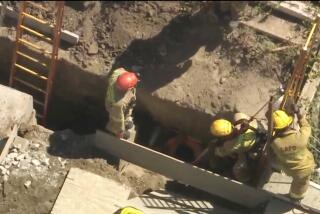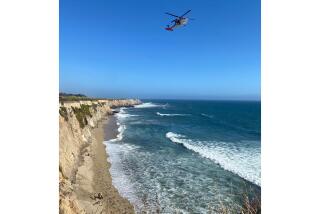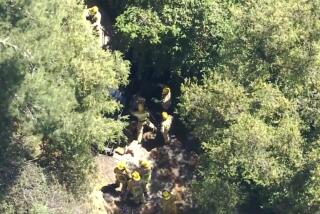Rescuers Free Man Trapped in Trench
After being trapped for more than 3 1/2 hours, an Orange County construction worker--covered in mud and rock and sweat--was rescued from a deep trench Wednesday.
Richard Glover, a county flood-control maintenance worker, offered a triumphant thumbs-up as he was finally pulled free by firefighters.
Glover, 39, of Riverside, slipped and fell into an Irvine drainage trench at Harvard Avenue and Irvine Center Drive about 10:20 a.m. As he sank into the mud, his feet were ultimately trapped 15 feet below street level.
He became so severely stuck--his foot wedged beneath an underground plank--that rescue workers employed a never-before-used machine that dislodges dirt with high-pressure air. Even so, it took the rescue workers hours to free him.
“What we were trying to do is take it slow and deliberate,” said Orange County Fire Authority spokesman Paul Hunter.
Glover was never considered to be in mortal danger, and firefighters opted not to risk mudslide or collapse of the makeshift wood reinforcements they’d built around him.
Instead they gave him oxygen and inserted an intravenous tube to keep him from dehydrating as they chipped away at the thick, cold mud.
Firefighters used a machine dubbed the Air Knife Trailer, a homemade contraption that uses high-pressure air to dislodge dirt and stone and heavy suction to vacuum it up.
“It is just another tool, but it was the perfect use for the machine,” said Doug Obermeier, the county firefighter who invented the machine.
“The soil was very moist and compacted, which made it extremely tight around him. We had to inflate air bags beneath the wood underground and then use [the machine] to pick up the soil,” Obermeier said. “Without it, he could have been in there six or eight or 10 hours.”
Bill Dean, assistant chief of operations, said the “air knife” was designed to assist in rescue operations after mudslides or earthquakes.
“Otherwise,” he said, “it’s a pick and shovel.”
Officials shut down train service on nearby tracks, fearing vibrations could collapse the trench. Amtrak passengers were shuttled around the area by bus, and train service resumed by late afternoon.
Once Glover’s feet were freed, rescuers lowered a rope and harness, braced his neck and back, and hoisted him out with a crane. Glover was admitted to Western Medical Center-Santa Ana with an ankle injury.
Glover seemed in good spirits throughout, even laughing in the final minutes of the rescue.
More to Read
Sign up for Essential California
The most important California stories and recommendations in your inbox every morning.
You may occasionally receive promotional content from the Los Angeles Times.










